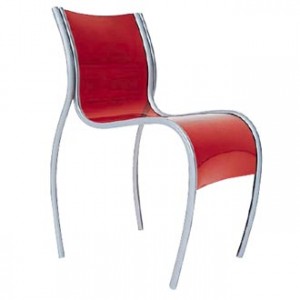Ron Arad Design Revolution
“No Discipline” is a journey through Ron Arads designs, from battle-worn chairs and sound systems to his steel-ribboned and forthcoming Design Museum Holon in Israel, his birthplace.
True to form, Arad is confounding his visitors at the Museum of Modern Art in New York. The exhibition is organized around his Cage Sans Frontieres (Cage Without Boundaries), a figure-8 of glass, steel and gauze that showcases his objects on multiple levels. Think of a Constructivist-inspired retail store, with curves that remind you of Frank Gehry.

Ron Arad "FPE (Fantastic Plactic Elastic) Chair"
Arad, who designed the exhibition, is stating that he is not confined by the boundaries of materials or categories. Hes a designer, a teacher (for many years at the Royal College of Art in London), and an architect. “Pluralist” is one of his favorite words. The MoMa show even includes his ever-present floppy hat, cappelone, an attribute which defines him and conceals much of his face. Youll never see him without it.
The Holon Museum will be the well-traveled mavericks first constructed building. They say an architects life starts at 60. Arad is 58 now. So whats the rush?
Arad trained as an architect in Israel and London, and in 1981 opened the design studio One Off, with Caroline Thorman. It was just after Punk had risen and fallen. His Rover Chair (1981), a car seat screwed to a frame with Kee Klamps, and Concrete Stereo (1983), musical components embedded in ruined cinder blocks – were Arads version of readymades, from the most ordinary and weathered sources. Other chairs were mini-craters that seemed hacked out of metal slabs. It wasnt just design, it was Dada. The public in design-starved Britain snapped it up.
Arad soon moved away from arte povera, into steel. His chunky metal chairs are illusionist furniture and look uncomfortable, yet Arad puts an elastic bounce into them. In bright colors, the chairs (called Volumes, and later, The Big Easy) have the look of Pop Art props for Tom Wesselman paintings. They have the patina of a shiny metal Jeff Koons poodle – and, for what they are, the price.
Favorite shapes for Arad are the steel slab and the coil. His lamps are like simple metal springs that rise like snakes, hence the name PizzaKobra (2007) for one such product that sits like a coiled serpent and stretches into whatever shape it can be bent into. Put a huge coil on its side, atop a wooden floor, and you have Arads model for the Olympic Bridge in London (2007). As with Claes Oldenberg, scale, in this case, is everything.
Working in super-plastic aluminum, Arad made casts called Blown Out of Proportion or BOOP (1998-right), which have the biomorphic bulges of surrealist sculpture and the curves of blown glass. Its always a game with Arad. He still dresses Dada style–in what look like the black pajamas of a 1970s freedom fighter, with black cappelone topper.

Ron Arad "Blown Out Of Proportion (B.O.O.P.) Vase", 1998. Photograph by Thibault Jeanson.
Chairs in the same aluminum called Bodyguards (2007) defy any notion of comfort or balance.
Naturally, Arad caught the eye of luxury manufacturers – Moroso, Driade, Alessi, Vitra. His work became chic, prices rose, and the designer was branded as a provisioner of furniture to the rich and recumbent. Arad played along, designing objects that looked as if they were made of molten silver.
His installation for the Notify Showroom in Milan (for a bluejeans manufacturer), a delicately-patterned fishtail in silvery metal, ascends radiantly to the ceiling of an atrium – echoing Frank Gehrys horses head sculpture in the Pariserplatz, in Berlin. Once again, its anything but arte povera. The term design-art has been used to describe what Arad does. He rejects that term. His consumers arent so sure.
Arad has endured the cheap shots about the cost of his work. His Design Museum Holon in Israel certainly hasnt come cheap — itll cost some $60 million, rather than the initial estimate of $15 million, according to his press rep, because Arad was meticulous about having the steel ribbons milled in Italy. (The coil, once again, in dark desert sand.) Arabs museum is a design object on a monumental scale, an icon to Israeli design, suggesting a godfatherly role for the Israeli expat. But if Arad can elevate the aesthetics of the Israeli built environment, it might just be worth it. The ordinary town of Holon is betting on his teaching.
Whats sure is that Arad is always doing more than one thing with a single object. More than seven feet high, This Mortal Coil (1993) is a free-standing cross section of what looks like a chambered nautilus – a coil, once again (and again) – that Arad holds together with riveted hinges. It is also a set of bookshelves. The cross section effect suggests that its another ready-made, not just found but sliced for the maximum gesture. The name hints at a conceptual message. Arad leaves you to figure it out, but you cant imagine storing books on it.
Still, Arad isnt stuck in luxury, or in anything else. Like the commedia dellarte character who would wear Arads cappelone hat, the designer shifts up and down and back and forth, between minimalism and luxury, as he moves between objects. Architecture, where he seems to have arrived, may finally force him to put it all together under one roof.
